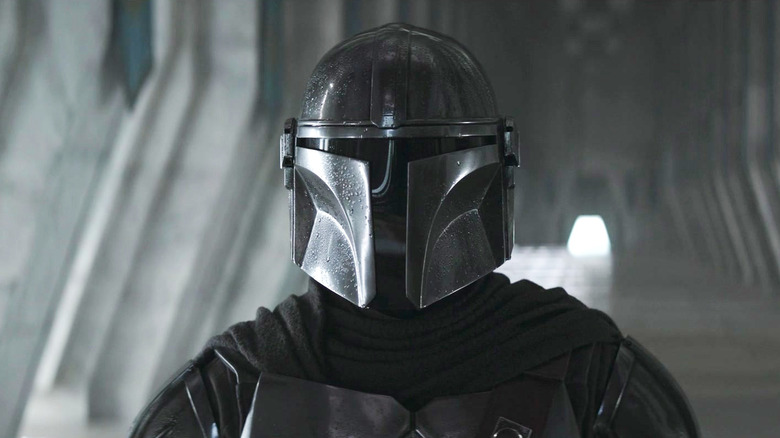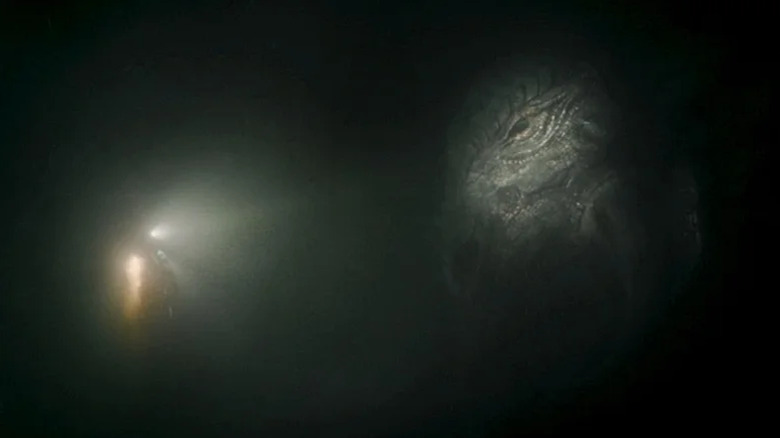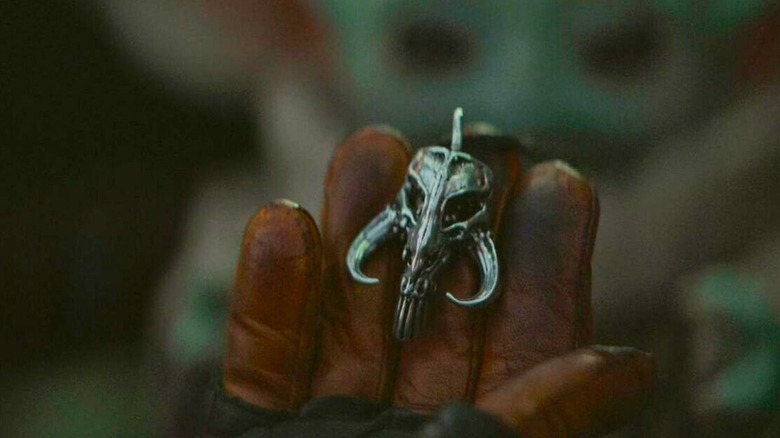Star Wars: The Mythosaur Explained
The "Star Wars" universe is one of the most fleshed-out, detailed, and vast settings in all of fiction. That sense of history and world-building, with countless planets and stories all fitting into a single galaxy, makes the property feel alive, like there is always something happening off-screen — even if you don't read the countless supplemental materials like comic books and novels. This also extends to the sheer number of weird creatures (big and small) in the "Star Wars" franchise, most of whom have their own lore and connection to the larger universe (like the Purrgils or the Loth-cats).
Then there's the Mythosaur, a creature we only briefly got a glimpse of in "The Mandalorian" season 3 but which had already been a huge part of the "Star Wars" mythology for decades before that. In "The Mandalorian," we get to see a real Mythosaur when Bo-Katan Kryze (Katee Sackhoff) and Din Djarin (Pedro Pascal) head to the Living Waters on the Mandalorian home planet of Mandalore. Hidden in the shadows, we see this gigantic beast underwater, huge tusks and all.
But this is more than just the latest giant monster of the week that the main characters have to defeat and then forget about. Indeed, the Mythosaur's appearance is a huge deal not just for Bo-Katan and Din Djarin but also for "Star Wars" fans that have waited decades to see what this mythical beast looks like, knowing fully well just how important it is to Mandalorian culture.
What is a Mythosaur?
The Mythosaur first appeared in the "Star Wars" Marvel comic book series that kicked off in 1977. In Star Wars Legends, it's described as a huge beast that roamed the planet Mandalore unopposed. When the Mandalorian Taung first arrived, led by the warrior known as Mandalore the First, they slaughtered the giant creatures in an effort to conquer the planet and drove them to extinction some 7,000 years before the Battle of Yavin. More than that, the Mythosaurs themselves were said to be nearly the size of small cities, so their calcified bones were used by ancient Mandalorians to build their first settlements.
In the current canon, however, the Mythosaur is a sea beast capable of growing to about 100 feet in length. Similarly, rather than having immediately driven them to extinction, Mandalore the Great and the ancient Mandalorians are said to have tamed the Mythosaurs — with certain legends claiming early Mandalorians even managed to ride the beasts in the wild. It's the taming of the mythical creatures which then led to their skull signet being adopted by Mandalorians. What's more, there's an episode of "The Book of Boba Fett" where the Armorer (Emily Swallow) tells Din of a legend about the Mythosaur rising up once more "to herald a new age of Mandalore." In other words, the Mandalorians came to believe the creatures would return after going extinct, which is something that helps Bo-Katan while she's leading the reclamation of Mandalore in "The Mandalorian" season 3.
Why is the Mythosaur important?
Regardless of canon, the Mythosaur quickly became the symbol of the Mandalorian people. In Legends, the Mandalorian regarded the beast's size and power as a symbol of their superiority, using its bones and hide to make weapons and armor. Likewise, the Mythosaur skull was used in a mask that was worn by those who took over the Mand'alor title and led all Mandalorians.
Though the current canon has made it so that beskar is the source of the Mandalorians' powerful armor and weapons, it hasn't changed things when it comes to the Mythosaur's iconography and its place in Mandalorian culture. In this case, the Mythosaur skull first appeared as a symbol on Boba Fett's Mandalorian armor, and it's since become absolutely ingrained in Mandalorian culture, from their armor to their banners and much more, making Mandalorians practically synonymous with the creature. In fact, when Din accepted Grogu as part of his family and as a foundling at the end of "The Mandalorian" season 1, he did so by giving his tiny green son a Mythosaur pendant.
Though we have yet to see a Mythosaur in its full glory on screen, it's a testament to the power of "Star Wars" that the creature has nonetheless remained so well-known after decades of lurking in the shadows (literally, in the case of the Mythosaur in "The Mandalorian"). Plus, it means that whenever we do see the rest of the Mythosaurs living beneath the surface of Mandalore, it will be quite the sight to behold.


